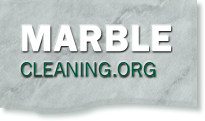| Home » Categories » Natural Stone Q & A’s |
Travertine in the kitchen |
| Article Number: 417 | Rating: Unrated | Last Updated: Tue, Sep 4, 2007 at 12:00 AM |
|
We installed tranertine in the kitchen and it has gotten some water spots in the shape of a glass that was left there. It was filled with ice and started to sweat. How do I get rid of those stains? Also the tile has some little holes that I would like to seal, what do you suggest, as well as what do you suggest we use to seal it? We've used impregnator 2 times but it is still happening. Also, do you all sell stuff that might be better to use for daily cleaning of the travertine countertops? I don't want to ruin its beautiful look by not knowing how to take care of it.
Dear Veronica:
You don't specify if your countertop is polished travertine or its hone-finished counterpart; but by the description of the problem I will assume that's polished.
Let's start by saying that
a stain – a real stain – is always darker than the stained material. If it is lighter (or of the same color), it's either a mark of corrosion created by an acid (etching), or a caustic mark created by a base (bleaching). There are no known exceptions to this rule.
Since stone can't bleach, what you have are etch-marks (marks of corrosion) created by the acidity of the drink inside the glass. (The condensation outside carries the same pH of the liquid inside the glass.) In other words, it is not a stain, but rather a surface damage; sort of a shallow chemical scratch.
There are also no known sealer in the entire galasxy that could prevent etching of calcareous rocks.
The impregnating sealer that you applied to your stone is only designed by help preventing true stains: staining liquids (i.e.: coffee, cooking oil, etc.) that could be absorbed by the stone.
In the case of polished travertine the application of an impregnator only serves the noble purpose of helping the manufacturer of the product and his distributors to put their kids through college, because the high surface-tension of polished travertine makes so that the stone is naturally sealed as is, and it can't absorb anything, including the impregnator, of course.
Your “stains” have nothing to do with the (very limited) absorbency of the stone, but exclusively with its chemical makeup: predominantly calcite.
What to do?
A good Marble Repair Kit will help removing the “stains” by actually re-polishing the stone surface, but, like I said before, nothing can help preventing those kind of damages from occurring.
Bottom line, polished travertine does not belong in kitchen – End of the debate.
L
At this point a question begs to be asked: didn't your stone dealer warn you about the well known problems of calcareous rocks in a kitchen environment?...
May I ask you now to please read and e-sign our Statement of Purpose at:
http://www.marblecleaning.org/purpose.htm?
J
Ciao and good luck,
Mauri
|
Attachments

There are no attachments for this article.
|
Comments

There are no comments for this article. Be the first to post a comment.
|
Marble Tiles used on a front porch
Viewed 0 times since Sun, Aug 9, 2009
Limestone Floors
Viewed 0 times since Thu, Sep 11, 2008
removing Lime fron Honey Onyx
Viewed 0 times since Sat, Sep 8, 2007
Gabbro
Viewed 0 times since Thu, May 10, 2007
Travertine ok stone for shower floor?
Viewed 0 times since Sat, Jan 3, 2009
Granite Countertop water damp by faucet
Viewed 0 times since Wed, Jan 16, 2008
edge of granite turning a different shade
Viewed 0 times since Thu, Apr 16, 2009
crack in granite on new install
Viewed 0 times since Thu, Dec 13, 2007
Laying lots of slate-now what?
Viewed 0 times since Wed, Feb 13, 2008
honing polished black floors
Viewed 0 times since Sun, Aug 3, 2008
|
| KB Home | Advanced Search | Ask Question |
|
| Ask Your Natural Stone Questions |  |
|
|
|

 Add Comment
Add Comment